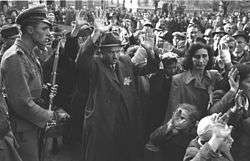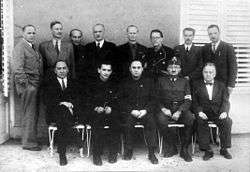Government of National Unity (Hungary)
The Government of National Unity (Hungarian: Nemzeti Összefogás Kormánya)[6] existed during the occupation of Hungary by Nazi Germany between October 1944 and May 1945. Formed by the Nazi Arrow Cross Party, it was established on 16 October 1944[2][7] after Regent Miklós Horthy was removed from power during Operation "Panzerfaust" (Unternehmen "Panzerfaust").[8] Arrow Cross leader Ferenc Szálasi became Prime Minister and, as "Nation Leader", the head of state. During the government's short period of rule, ten to fifteen thousand Jews were murdered in Hungary[9] and around eighty thousand Jews, including many women, children and elderly Jews, were deported from Hungary to their deaths in the Auschwitz concentration camp.[10]
Government of National Unity Nemzeti Összefogás Kormánya | |||||||||||
|---|---|---|---|---|---|---|---|---|---|---|---|
| 1944–1945 | |||||||||||
.svg.png) Flag
.svg.png) Coat of arms
| |||||||||||
| Status | Puppet state of Nazi Germany | ||||||||||
| Capital | Budapest | ||||||||||
| Common languages | Hungarian | ||||||||||
| Religion | Roman Catholic, Calvinism, Lutheranism | ||||||||||
| Government | Hungarist totalitarian state | ||||||||||
| Leader of the Nation | |||||||||||
• 1944–1945 | Ferenc Szálasi | ||||||||||
| Legislature | Diet | ||||||||||
| Historical era | World War II | ||||||||||
| 15 October 1944 | |||||||||||
• Government formed | 16 October 1944[2] | ||||||||||
• Government members fled to Germany | 28–29 March 1945[3] | ||||||||||
• End of German occupation of Hungary | 4 April 1945[4] | ||||||||||
• Capture of Szálasi | 6 May 1945[5] | ||||||||||
• Disestablished | 7 May 1945[5] | ||||||||||
| Currency | Hungarian Pengő | ||||||||||
| |||||||||||
| Today part of | |||||||||||
Hungary splits in two


After Miklós Horthy announced an armistice with the Allies on 15 October, the Germans kidnapped him and threatened to kill his son unless he renounced the armistice and abdicated. To spare his son's life, Horthy signed a statement announcing both his abdication and the appointment of Arrow Cross leader Ferenc Szálasi as Magyar királyi miniszterelnök (Royal Hungarian Prime Minister) on 16 October.[11] He was then deported to Germany. This act merely rubber-stamped an Arrow Cross coup, as Szálasi's men had taken over Budapest the previous night.
In his memoirs, Horthy later contended that he never gave power to the Arrow Cross, but had "merely exchanged my signature for my son's life." As he saw it, the appointment of Szálasi was void, since "a signature wrung from a man at machine-gun point can have little legality."[12]
The Hungarian parliament approved the formation of a Council of Regency (Kormányzótanács) of three on 17 October.[2] On 4 November, Szálasi was sworn as Leader of the Nation (nemzetvezető).[13] He formed a government of sixteen ministers, half of which were members of the Arrow Cross Party. While the Horthy regency had come to an end, the Hungarian monarchy was not abolished by the Szálasi regime, as government newspapers kept referring to the country as the Kingdom of Hungary (Magyar Királyság, also abbreviated as m.kir.), although Magyarország (Hungary) was frequently used as an alternative.[14][15]
Szálasi was an ardent fascist and his "Quisling government" had little other intention or ability but to maintain fascism and to maintain control in Nazi-occupied portions of Hungary as Soviet troops poured into Hungary. He did this in order to reduce the threat to Germany. Szálasi's aim was to create a one-party state based on his "Hungarist" ideology.
On 21 December 1944, with the approval of the Soviet Union, Béla Miklós was elected as the Prime Minister of a "counter" Hungarian government in Soviet-controlled Debrecen. Miklós was a former commander of the Hungarian First Army. He had failed in his efforts to convince many of the men under his command to switch sides. The government that Miklós oversaw was an "interim government" and maintained control in the Soviet-occupied portions of Hungary.
History


By the time of the Nazi/Arrow Cross coup, Hungary faced impending occupation by the Soviet Union. The Red Army was already deep inside the country, effectively limiting the Arrow Cross regime's jurisdiction to an ever-narrowing band of territory around Budapest. Seen in this context, the Arrow Cross regime was short and brutal.
In cooperation with the Nazis, Szálasi restarted the deportations of Jews, particularly in Budapest. Thousands more Jews were killed by Arrow Cross members. Of the approximately 800,000 Jews residing within Hungary's expanded borders of 1941, only 200,000 (about 25%) survived the Holocaust.[16] An estimated 28,000 Hungarian Roma were also killed as part of the Porajmos.[17]
Szálasi envisioned a new economic order, which he called the "Corporate order of the Working nation" (Dolgozó Nemzet Hivatás Rendje). Even as Hungary was in chaos, Szálasi refused theoretically to compromise Hungarian sovereignty, trying to retain nominal command of all Hungarian military units, including the local SS units. Ethnic Germans were still not allowed to join the Arrow Cross Party. Szálasi devoted much time to his political writings and to trips in the shrinking territory under his control: many political matters were effectively handled by his Deputy Prime Minister Jenő Szöllősi.[18] At the beginning of December, Szálasi and his government relocated out of Budapest as Soviet troops advanced towards the capital. In a scorched earth strategy, the German armed forces destroyed Hungarian infrastructure as the Soviets closed in.
In December 1944, the Battle of Budapest began. Fascist forces loyal to Szálasi and the badly damaged remnants of the Hungarian First Army fought alongside German forces. They fought against the Red Army to no avail. By 13 February 1945, all of Budapest was under Soviet control.[8]
In March 1945, during Operation Spring Awakening (Unternehmen Frühlingserwachen), Fascist Hungarian forces of the Hungarian Third Army fought alongside German forces in the last major offensive in Hungary against the Soviet forces. For ten days the Axis forces made costly gains. However, within twenty-four hours, the Soviet counterattack was able to drive the Germans and Hungarians back to the positions they held before the offensive began.
Between 16 March and 25 March 1945, the remnants of the Hungarian Third Army were overrun and virtually destroyed. By the end of March and into April, what remained of the Royal Hungarian Army were put on the defensive during the Nagykanizsa–Körmend Offensive and were then forced into Slovakia and Austria as Soviet forces occupied all of Hungary. Béla Miklós's government was nominally in control of the whole country. Nazi Germany itself was on the verge of collapse.
The Ferenc Szálasi regime, which had fled Hungary, was dissolved on 7 May 1945, a day before Germany's surrender.[5] Szálasi was captured by American troops in Mattsee on 6 May[5] and returned to Hungary, where he was tried for crimes against the state and executed, along with three of his ministers. Most of his ministers also were sentenced to death and executed, except four of them. Béla Jurcsek committed suicide at the end of the war, Árpád Henney fled to Austria. Emil Szakváry was sentenced to life imprisonment, while Vilmos Hellebronth was sentenced to death, but the tribunal – before execution – changed his sentence to life imprisonment.
Government members

- Ferenc Szálasi, Leader of the Nation and Prime Minister
- Jenő Szöllősi, Deputy Prime Minister
- Gábor Vajna, Minister of the Interior
- Gábor Kemény, Minister of Foreign Affairs
- Lajos Reményi-Schneller, Minister of Finance
- László Budinszky, Minister of Justice
- Károly Beregfy, Minister of Defence
- Ferenc Rajniss, Minister of Religion and Education
- Fidél Pálffy, Minister of Agriculture
- Lajos Szász, Minister of Trade and Transport
- Emil Szakváry, Minister of Industry
- Béla Jurcsek, Minister of Welfare
- Emil Kovarcz, Minister without portfolio in charge of the full-scale mobilization and arming of the nation
- Ferenc Kassai-Schalmayer, Minister without portfolio for National Defence and Propaganda
- Vilmos Hellebronth, Minister without portfolio in charge of the continuous oversight of production
- Árpád Henney, Minister without portfolio and special delegate to the Leader of the Nation, in charge of the Leader of the Nation's task force
See also
- Hungary during World War II
- Operation "Panzerfaust"
- Szent László Infantry Division
References
- Adeleye, Gabriel G. (1999). World Dictionary of Foreign Expressions. Ed. Thomas J. Sienkewicz and James T. McDonough, Jr. Wauconda, IL: Bolchazy-Carducci Publishers, Inc. ISBN 0-86516-422-3.
- Nevenkin, Kamen (2012). Take Budapest: The Struggle for Hungary, Autumn 1944. New York: The History Press. p. 53. ISBN 9780752477039. Retrieved 29 March 2015.
- Gosztonyi, Péter (1992). A Magyar Honvédség a második világháborúban (2nd ed.). Budapest: Európa Könyvkiadó. p. 255. ISBN 963-07-5386-3.
- Gosztonyi, Péter (1992). A Magyar Honvédség a második világháborúban (2nd ed.). Budapest: Európa Könyvkiadó. p. 256. ISBN 963-07-5386-3.
- Gosztonyi, Péter (1992). A Magyar Honvédség a második világháborúban (in Hungarian) (2nd ed.). Budapest: Európa Könyvkiadó. pp. 275–276. ISBN 963-07-5386-3.
- (in Hungarian) Nemzeti Összefogás Kormánya, Szálasi-kormány, nyilas kormány
- Gosztonyi, Péter (1992). A Magyar Honvédség a második világháborúban (in Hungarian) (2nd ed.). Budapest: Európa Könyvkiadó. p. 215. ISBN 963-07-5386-3.
- The Policies of Prime Minister Kallay and the German Occupation of Hungary in March 1944 Archived 2011-01-09 at the Wayback Machine
- Patai, Raphael (1996). The Jews of Hungary:History, Culture, Psychology. 590: Wayne State University Press. p. 730. ISBN 0-8143-2561-0.CS1 maint: location (link)
- Johnston, Chris (2006-02-16). "War Crime Suspect Admits to his Leading Fascist Role". The Age. Retrieved 2009-04-19.
- Gosztonyi, Péter (1992). A Magyar Honvédség a második világháborúban (in Hungarian) (2nd ed.). Budapest: Európa Könyvkiadó. p. 205. ISBN 963-07-5386-3.
- Horthy, Admiral Nicholas (2000). Admiral Nicholas Horthy Memoirs. Nicholas Horthy, Miklós Horthy, Andrew L. Simon, Nicholas Roosevelt (illustrated ed.). Simon Publications LLC. p. 348. ISBN 0-9665734-3-9.
- Hungary: Notes - archontology.org
- Budapesti Közlöny, 17 October 1944
- Hivatalos Közlöny, 27 January 1945
- Victims of Holocaust - Holocaust Memorial Centre.
- Crowe, David (2000). “The Roma Holocaust,” in Barnard Schwartz and Frederick DeCoste, eds., The Holocaust's Ghost: Writings on Art, Politics, Law and Education. University of Alberta Press. pp. 178–210.
- Stanley G. Payne, A history of fascism, 1914-1945, Routledge, 1996, page 420
.svg.png)
.svg.png)